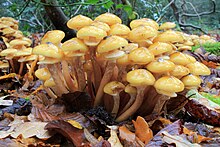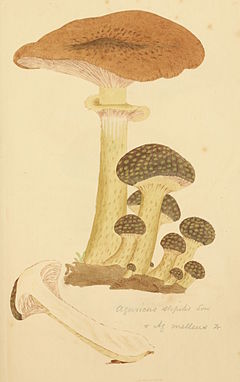Armillaria mellea
| Armillaria mellea | |
|---|---|

| |
| Scientific classification | |
| Domain: | Eukaryota |
| Kingdom: | Fungi |
| Division: | Basidiomycota |
| Class: | Agaricomycetes |
| Order: | Agaricales |
| Family: | Physalacriaceae |
| Genus: | Armillaria |
| Species: | A. mellea
|
| Binomial name | |
| Armillaria mellea | |
| Synonyms[1] | |
| |
| Armillaria mellea | |
|---|---|
| Gills on hymenium | |
| Cap is convex or flat | |
| Hymenium is adnate or subdecurrent | |
parasitic | |
| Edibility is choice or can cause allergic reactions | |
Armillaria mellea, commonly known as honey fungus, is an edible
Armillaria mellea is widely distributed in
Taxonomy
This section is missing information about links from subtaxa to current species pages (e.g. obscura → ostoyae); #Similar species ref may help. (March 2021) |
The species was originally named Agaricus melleus by Danish-Norwegian botanist Martin Vahl in 1790; it was transferred to the genus Armillaria in 1871 by Paul Kummer.[1] Numerous subtaxa have been described:
| Name | Authority | Year |
|---|---|---|
| var. radicata | Peck[2] | 1891 |
| var. viridiflava | Barla[3] | 1887 |
| subsp. nipponica | J.Y.Cha & Igarashi[4] | 1995 |
| f. rosea | Calonge & M.Seq.[5] | 2003 |
Similar species
Armillaria mellea once included a range of species with similar features that have since been reclassified. The following are reassigned subtaxa, mostly variety-level entries from the 19th century:[6]
| Name | Authority | Year | Current name |
|---|---|---|---|
| var. minor | Barla[3] | 1887 | A. mellea |
| var. bulbosa | Barla[3] | 1887 | |
| var. camerunensis | Henn.[7]
|
1895 | |
| var. exannulata | Peck[8] | 1893 | |
| var. flava | Peck[9] | 1897 | |
| var. glabra | Gillet[10]
|
1874 | A. mellea |
| var. javanica | Henn.[11]
|
1900 | |
| var. laricina | (Bolton) Barla[3] | 1887 | |
| var. maxima | Barla[3] | 1887 | A. mellea |
| var. obscura | Gillet[10] | 1874 | A. solidipes
|
| var. sulphurea | ( | 1879 | A. mellea[13] |
| var. tabescens | ( Ramsb.
|
1917 | Desarmillaria tabescens |
| var. versicolor | ( W.G.Sm.[14]
|
1908 | A. versicolor Withering 1801 |
Description


The
The main part of the fungus is underground where a mat of
Hosts and symptoms
Armillaria mellea typically infects hardwood trees and
Disease cycle
Armillaria mellea infects both through basidiospore[22] and penetration of host species by rhizomorphs[21] which can grow up to 10 feet long to find new, living tissue to infect.[22] However, infection of living host tissue through basidiospores is quite rare.[20] Two basidiospores must germinate and fuse to be viable and produce mycelium.[20] In the late summer and autumn, Armillaria mellea produces mushrooms with notched gills, a ring near the cap base, and a white to golden color.[19] They don't always appear,[20] but when they do they can be found on both living and dead trees near the ground.[20] These mushrooms produce and release the sexually created basidiospore which is dispersed by the wind.[20] This is the only spore-bearing phase. The fungus overwinters as either rhizomorphs or vegetative mycelium.[23] Infected wood is weakened through decay in roots and tree base after destruction of the vascular cambium and underlying wood.[20]
Environment
Armillaria mellea prefers moist soil and lower soil temperatures[20] but it can also withstand extreme temperatures, such as forest fires, due to the protection of the soil.[19] It is found in many kinds of landscapes, including gardens, parks, vineyards, tree production areas, and natural landscapes.[20]
Distribution
Armillaria mellea is widespread in northern
Ecology
Trees become infected by Armillaria mellea when rhizomorphs growing through the soil encounter uninfected roots. Alternatively, when infected roots come into contact with uninfected ones the fungal mycelium may grow across. The rhizomorphs invade the trunk, growing between the bark and the wood and causing wood decay, growth reduction and mortality. Trees that are already under stress are more likely to be attacked but healthy trees may also be parasitized. The foliage becomes sparse and discoloured, twig growth slows down and branches may die back. When they are attacked, the
In 1893, the American mycologist Charles Horton Peck reported finding Armillaria fruiting bodies that were "aborted", in a similar way to specimens of Entoloma abortivum. It was not until 1974 that Roy Watling showed that the aborted specimens included cells of both Armillaria mellea and Entoloma abortivum. He thought that the Armillaria was parasitizing the Entoloma, a plausible hypothesis given its pathogenic behaviour.[26] However, a 2001 study by Czederpiltz, Volk and Burdsall showed that the Entoloma was in fact the microparasite. The whitish-grey malformed fruit bodies known as carpophoroids were the result of E. abortivum hyphae penetrating the Armillaria and disrupting its normal development.[27]
The main part of the fungus is underground where a mat of mycelial threads may extend for great distances. The rhizomorphs of A. mellea are initiated from mycelium into multicellular apices of rhizomorphs, which are multicellular vegetative organs that exclude soil from the interior of the rhizomorph tissues. The rhizomorphs spread through far greater distances through the ground than the mycelium. The rhizomorphs are black in this species.[17] The fungal body is not bioluminescent but its mycelia and rhizomorphs are luminous when in active growth.[18] A. mellea producing rhizomorphs is parasitic on woody plants of many species, including especially shrubs, hardwood and evergreen trees. In one example, A. mellea spread by rhizomorphs from an initially infected tree killed 600 trees in a prune orchard in 6 years. Each infected tree was immediately adjacent to an already infected one, the spread by rhizomorphs through the tree roots and soil. (Piper and Fletcher, 1903, Wash. Age. Exp. Sat. But., 59: 1–14); cited in Rhizomorph Development in A. mellea, Ph.D. thesis, by Philip Snider(1957), Farlow Herbarium Library Harvard Univ., 20 Divinity Ave., Cambridge, Mass.
Management
There are no known fungicides or management practices that will kill Armillaria mellea after infection without damaging the infected plant,[21] but there are practices that can extend the life of the plant and prevent further spreading. The best way to extend the plant life is to improve the host condition through supplemental watering and fertilization.[21] To prevent further spread, regulate irrigation to avoid water stress, keep the root collar dry, control defoliating pathogens, remove stumps, fertilize adequately, avoid physical root damage and soil compaction, and don't plant trees that are especially susceptible to the disease in places where Armillaria mellea has been recorded.[20] There is also some evidence that biological control using the fungus genus Trichoderma may help. Trichoderma is a predator of Armillaria mellea and is often found in woodchips.[20] Therefore, chipping or grinding dead and infected roots will give Trichoderma its preferred habitat and help it proliferate. Solarization will also create an ideal habitat as dry soil and higher soil temperatures are preferable for Trichoderma but poor conditions for Armillaria mellea.[20]
Edibility

Armillaria mellea mushroom are considered good edibles, though not preferred by some, and the tough stalks are usually excluded.[15] Some individuals have reported "allergic" reactions that result in stomach upsets. Some authors suggest not collecting mushrooms from the wood of various trees, including hemlock, buckeye, eucalyptus, and locust.[citation needed] They may have been used medicinally by indigenous peoples as a laxative.[28]
The mushrooms have a taste that has been described as slightly sweet and nutty, with a texture ranging from chewy to crunchy, depending on the method of preparation.
Chemistry
Several bioactive compounds have been isolated and identified from the fruit bodies. The triterpenes 3β-hydroxyglutin-5-ene, friedelane-2α,3β-diol, and friedelin were reported in 2011.[32] Indole compounds include tryptamine, L-tryptophan and serotonin.[33]
The fungus produces
Importance
Armillaria mellea has been reported in almost every state with the continental United States.[36] It is one of the most common causes of death in trees and shrubs in both natural and human cultivated habitats, and cause steady and substantial losses.[36]
Pathogenesis
Armillaria mellea infects new hosts through rhizomorphs[21][22] and basidiospores.[37] It is rare for basidiospores to be successful in infecting new hosts and often colonize woody debris instead,[20] but rhizomorphs, however, can grow up to ten feet long in order to find a new host.[22]
See also
- Forest pathology
- List of Armillaria species
- List of bioluminescent fungi
References
- ^ a b "Armillaria mellea (Vahl) P. Kumm., Der Führer in die Pilzkunde: 134, 1871". MycoBank. International Mycological Association. Retrieved 2013-10-19.
- ^ Peck CH. (1891). "Report of the Botanist (1890)". Annual Report on the New York State Museum of Natural History. 44: 117–87 (see p. 150).
- ^ a b c d e Barla JB. (1887). "Liste des champignons nouvellement observés dans le département des Alpes-Maritimes". Bulletin de la Société Mycologique de France (in French). 3 (2): 138–44.
- S2CID 84793024.
- ^ Calonge FD, Menezes de Sequeira M (2003). "Contribución al catálogo de los hongos de Madeira (Portugal)". Boletín de la Sociedad Micológica de Madrid (in Spanish). 27: 277–308.
- S2CID 83996766.
- ^ Hennings P. (1895). "Fungi camerunenses I". Botanische Jahrbücher für Systematik, Pflanzengeschichte und Pflanzengeographie (in German). 22: 72–111 (see p. 107).
- ^ Peck CH. (1893). "Report of the Botanist (1892)". Annual Report on the New York State Museum of Natural History. 46: 85–149 (see p. 134).
- ^ Peck CH. (1896). "Report of the Botanist (1894)". Annual Report on the New York State Museum of Natural History. 48: 103–337 (see p. 265).
- ^ a b Gillet CC. (1874). Les Hyménomycètes ou Description de tous les Champignons qui Croissent en France (in French). Vol. 1. Alençon: Ch. Thomas. p. 84.
- ^ Hennings P. (1900). "Fungi monsunenses". Monsunia. 1: 1–38.
- ^ Karsten PA. (1879). "Rysslands, Finlands och den Skandinaviska halföns Hattsvampar. Förra Delen: Skifsvampar". Bidrag till Kännedom av Finlands Natur och Folk (in German). 32: 22.
- ^ Not supported by mycobank, which reports a Agaricus sulphureus Weinm. taxon.
- ^ Smith WG. (1908). Synopsis of the British Basidiomycetes: A descriptive catalogue of the drawings and specimens in the department of Botany British Museum. London, UK: The Trustees of the British Museum, London. p. 30.
- ^ OCLC 797915861.
- ISBN 9780713701463.
- ^ a b c Kuo, Michael (2004-10-01). "Armillaria mellea: The Honey Mushroom". MushroomExpert.Com. Retrieved 2013-10-18.
- ^ S2CID 10637645.
- ^ a b c "Armillaria | Description, Species, Size, & Facts". Encyclopedia Britannica. Retrieved 2020-12-10.
- ^ a b c d e f g h i j k l m n o p q "Armillaria Root Rot Management Guidelines--UC IPM". ipm.ucanr.edu. Retrieved 2020-12-10.
- ^ a b c d e f "Armillaria Root Disease". Wisconsin Horticulture. Retrieved 2020-12-10.
- ^ a b c d "2011 Meeting | Clonal and sexual dispersal of Armillaria mellea in an ornamental landscape". www.apsnet.org. Retrieved 2020-12-10.
- ^ "Welcome". id.elsevier.com. Retrieved 2020-12-10.
- ISBN 978-0-226-72117-0.
- ^ Williams, RE; Shaw, CG; Wargo, PM; Sites, WH (1989-04-01). "Armillaria Root Disease". Forest Insect & Disease Leaflet 78. US Department of Agriculture Forest Service. Retrieved 2013-10-17.
- ^ Kuo, Michael (2004-10-01). "Entoloma abortivum". MushroomExpert.Com. Retrieved 2013-10-19.
- JSTOR 3761750.
- OCLC 694395083.
- ^ AA.VV. (2012). "Informazioni utili". In Francesca Assisi (ed.). I funghi: guida alla prevenzione delle intossicazioni (PDF) (in Italian). Ministero della Salute and Regione Lombardia. p. 21. Retrieved 13 November 2018.
- ISBN 978-1-55407-651-2.
- ISBN 978-0-472-03126-9.
- S2CID 189785379.
- PMID 21485706.
- ^ Lackner et al., 2013
- ^ Wick et al., 2015
- ^ a b "Armillaria root disease is found throughout temperate and tropical regions of the world". projects.ncsu.edu. Archived from the original on 2021-03-02. Retrieved 2020-12-10.
- ^ "2011 Meeting | Clonal and sexual dispersal of Armillaria mellea in an ornamental landscape". www.apsnet.org. Retrieved 2020-12-10.
